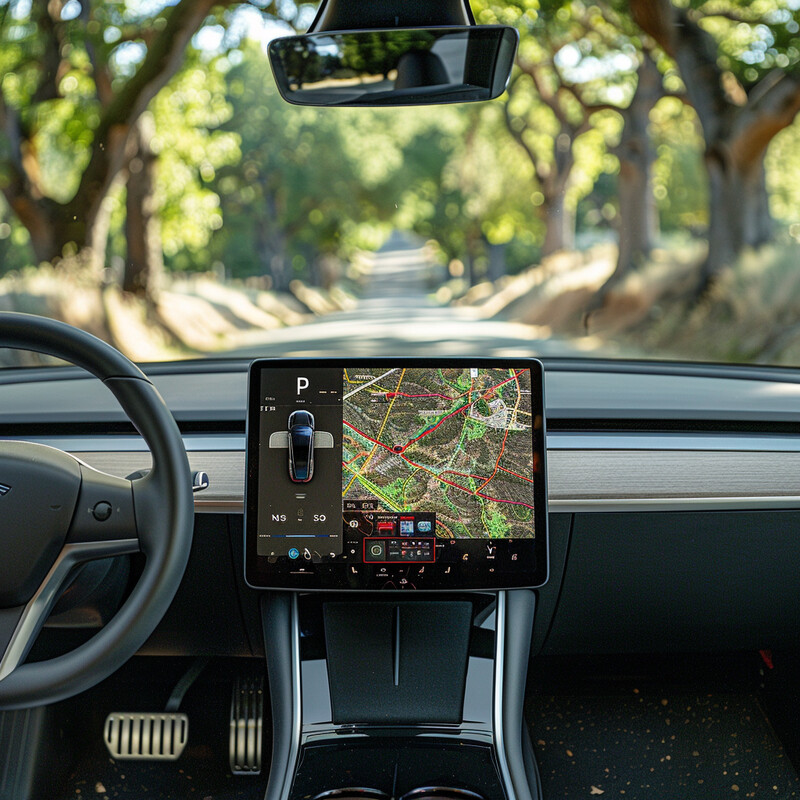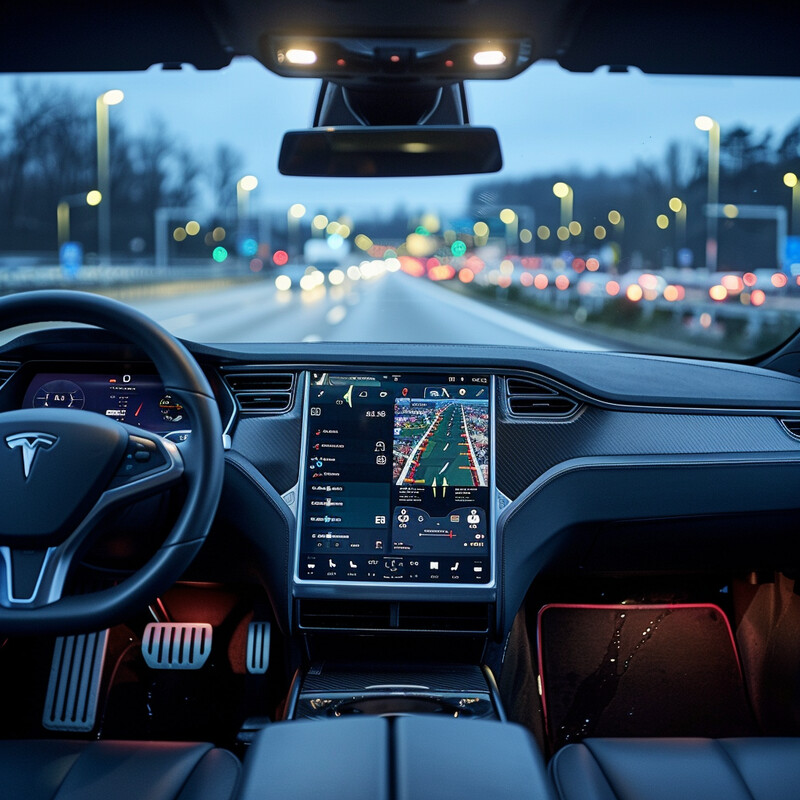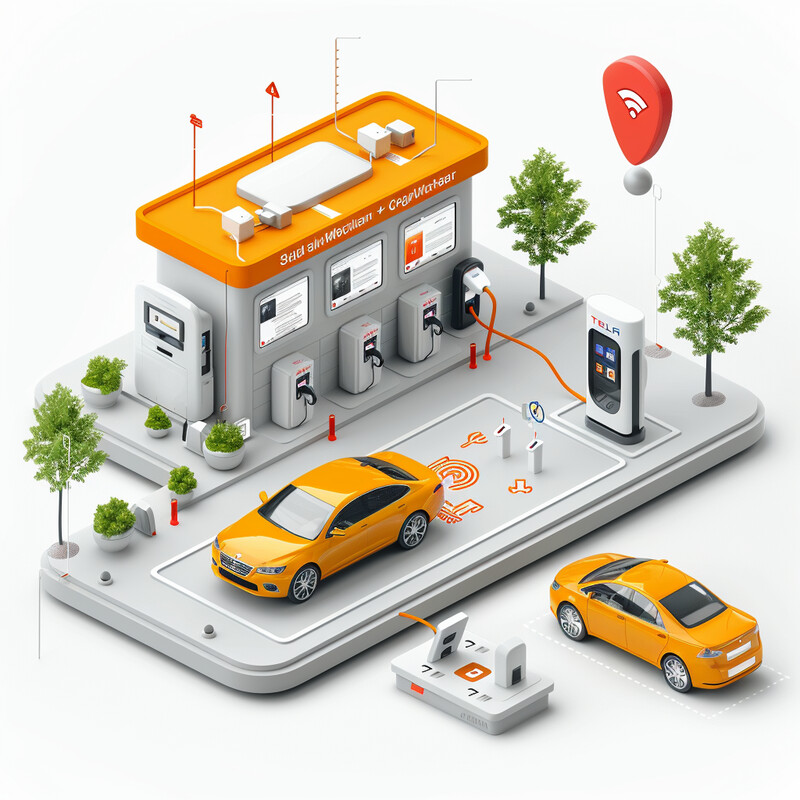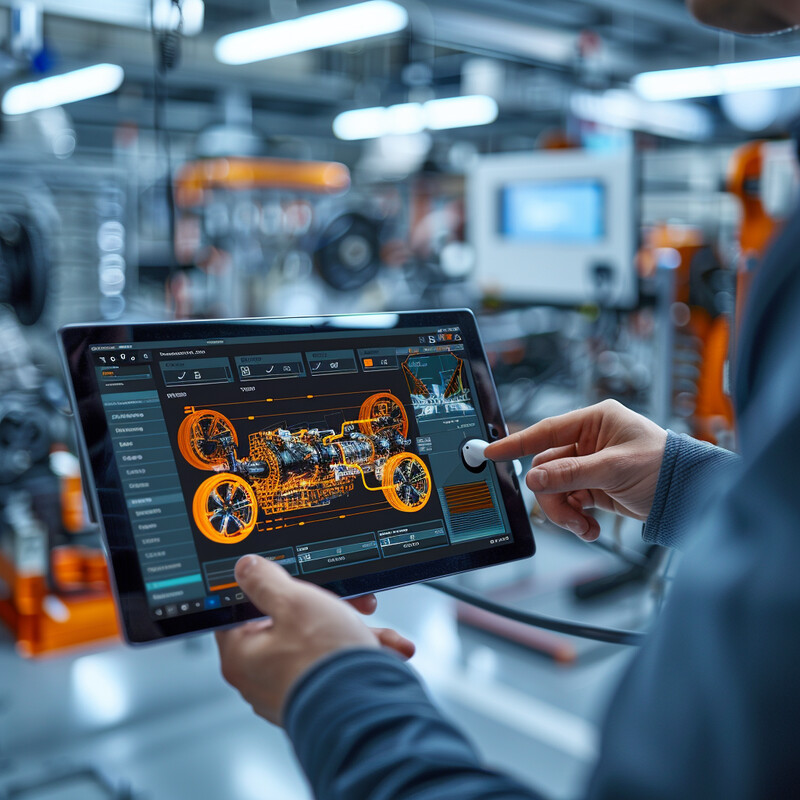1. Battery Management
AI is increasingly vital in EV battery management, using machine learning to monitor and optimize battery usage. By analyzing driving patterns, charge/discharge cycles, and environmental factors in real time, AI-driven battery management systems can adjust charging rates and depths to minimize cell degradation. This adaptive approach maintains battery health by avoiding conditions that accelerate wear, ultimately extending the lifespan and reliability of EV batteries. Automakers are incorporating AI in Battery Management Systems (BMS) to maximize performance and delay capacity fade, which reduces the frequency of battery replacements. In essence, AI helps ensure that EV batteries operate at peak efficiency over a longer period, improving both cost-effectiveness and user confidence in battery longevity.

AI-optimized BMS technology has been shown to significantly prolong battery life. For example, one analysis indicates that AI-driven battery management systems can improve an EV battery’s lifespan by up to 40% by intelligently optimizing charging and discharging cycles. Traditional BMS rely on fixed algorithms and might not adapt to variations in usage, whereas AI continuously learns from data to prevent practices like overcharging or excessively rapid discharging that harm the battery. This extension in battery life translates to fewer battery replacements and less waste over the vehicle’s lifetime, showcasing AI’s tangible impact on durability. Such improvements also enhance the sustainability of EVs by making the most of each battery’s usable life before recycling or replacement is needed.
2. Range Prediction
AI plays a critical role in improving EV range prediction, making estimates of remaining driving range more accurate and reliable. Modern EVs use machine learning algorithms to analyze numerous factors—such as driving habits, speed, terrain, traffic, and even weather—to refine their range calculations in real time. By learning from a driver’s typical behavior and route patterns, AI can adjust range estimates dynamically, which helps alleviate “range anxiety” (the fear of running out of charge unexpectedly). This leads to better route planning and energy management, as drivers receive more trustworthy information about how far they can go before needing to recharge. Overall, AI-enhanced range prediction improves the driver experience and confidence in EVs by reducing uncertainty and ensuring the vehicle’s reported range closely matches real-world performance.

Advances in AI have dramatically increased the accuracy of EV range estimates. In 2023, Electra Vehicles, an EV software firm, demonstrated an AI-based system that doubled the accuracy of driving range predictions compared to traditional methods. Their AI algorithm, which continuously learns from battery data and usage patterns, outperformed the standard estimation techniques (such as those based on fixed assumptions or simple averages). By providing a much more precise state-of-charge and range calculation, this AI-driven approach directly tackles range anxiety. More accurate range predictions mean drivers can trust the vehicle’s estimates and plan trips with greater confidence, knowing the car’s computer has accounted for real-time conditions that affect energy consumption. This example shows how AI innovations are making EV range estimates far more dependable for everyday users.
3. Energy Consumption Optimization
AI is used in EVs to optimize energy consumption, actively managing how and when the vehicle uses power to improve overall efficiency. Intelligent energy management systems analyze data like speed, acceleration, vehicle load, road incline, and climate control usage to make real-time adjustments that conserve energy. For instance, AI can decide when to engage regenerative braking more aggressively to recapture energy or when to limit power to certain systems if it detects inefficient usage. By predicting upcoming driving conditions (such as a hill or heavy traffic) and adjusting power distribution accordingly, AI ensures that each unit of charge propels the vehicle as far as possible. This not only extends the driving range on a single charge but also reduces electricity costs and can lessen the strain on the battery. In fleet or commercial settings, these optimizations multiply into significant savings and lower downtime, as vehicles can go longer between charges with AI fine-tuning their energy usage.

Studies indicate that AI-driven energy management can materially boost EV efficiency. AI algorithms that govern power use and drivetrain response can improve an electric vehicle’s range efficiency by roughly 10–20% compared to standard operation. In practice, this means an EV could travel that much farther on the same battery capacity by intelligently adapting to conditions in real time. For example, the AI might reduce power to the climate control or reroute torque to optimize traction in ways that a human driver wouldn’t manually manage. These efficiency gains have been observed in fleet trials, where machine learning systems analyzing weather, traffic, and driver behavior achieved greater mileage per charge and lower energy costs for each trip. Such improvements underline AI’s role in squeezing more performance out of batteries, which is crucial for both extending range and lowering the cost-per-mile of electric driving.
4. Autonomous Driving Features
AI is the cornerstone of autonomous driving features in EVs, powering systems from advanced driver-assistance to full self-driving capabilities. These features include technologies like Automatic Emergency Braking, Lane Keeping Assist, Adaptive Cruise Control, and pedestrian detection, all of which rely on AI algorithms to interpret sensor data in real time. In electric vehicles, which often serve as platforms for cutting-edge tech, AI processes inputs from cameras, radar, lidar, and ultrasonic sensors to make split-second decisions (such as applying brakes or steering corrections) that enhance safety and convenience. Over time, machine learning models continuously improve by learning from millions of miles of driving data, enabling them to better predict and react to complex traffic scenarios. The result is that AI-driven autonomy not only reduces the burden on drivers but also has the potential to significantly lower accident rates and improve traffic flow efficiency. As EVs increasingly come equipped with these intelligent features, they pave the way for safer roads and eventually, vehicles that can drive themselves with minimal human intervention.

The adoption of AI-powered driver assistance in vehicles has become nearly universal in recent years, underlining its impact on safety. In the United States, five key ADAS features (such as forward collision warning and automatic emergency braking) were standard or available in over 90% of new passenger vehicles by the 2023 model year. This is a sharp increase from just a few years prior, when none of these features had reached even 75% market penetration. The rapid spread of AI-driven safety systems reflects automakers’ commitment to integrating advanced algorithms that can prevent or mitigate crashes. Research has shown that these features, powered by AI object detection and decision-making, can substantially reduce the risk of collisions. For example, automatic emergency braking – enabled by AI that recognizes imminent crashes – has been found to cut certain types of rear-end accidents roughly in half. Such statistics underscore how AI in autonomous driving features is already saving lives and is set to deliver even greater safety benefits as more EVs (and vehicles in general) come equipped with increasingly sophisticated self-driving technologies.
5. Charging Station Management
AI is improving the management of EV charging stations by intelligently balancing demand, supply, and infrastructure capacity. As more electric vehicles plug into the grid, AI algorithms help operators and utilities optimize charging schedules to prevent overloads during peak times. These systems can predict when and where charging demand will surge (for instance, a weekday evening at a busy station) and proactively manage charging speeds or queueing to ensure efficient use of available power. AI also assists in dynamic pricing or incentive programs, encouraging EV owners to charge during off-peak, lower-demand periods which helps flatten the overall load on the electric grid. In addition, AI-driven software monitors the health and status of charging equipment, often diagnosing and even fixing issues remotely, thereby increasing charger uptime. By coordinating thousands of charging sessions and learning from usage patterns, AI makes charging networks more reliable and accessible—reducing wait times for drivers, lowering energy costs, and preventing strain on local electrical infrastructure.

Smart charging systems using AI can significantly ease the burden of EVs on the power grid. Research shows that optimized, AI-driven charging strategies could reduce peak electricity load from EV charging by about 10–15%. In practical terms, this means during the busiest charging hours, the grid experiences substantially lower stress than it would without smart scheduling. The AI achieves this by staggering charging start times or adjusting charging rates across vehicles to avoid all cars drawing maximum power simultaneously. Such load balancing makes the grid more resilient and efficient, especially as EV adoption grows. For example, a utility might use AI to delay or slow down charging for a group of vehicles by just a small amount, with minimal impact on each driver, but collectively preventing a major spike in demand. This kind of intelligent management was demonstrated in studies and pilot programs which found that coordinating charging not only prevents local transformers from overloading but can also cut electricity costs (by shifting consumption to off-peak hours) for both providers and EV owners. The 10–15% peak reduction is a compelling statistic that highlights AI’s role in ensuring EV charging remains smooth and grid-friendly as usage scales up.
6. Predictive Maintenance
AI-driven predictive maintenance is revolutionizing how EVs are serviced by forecasting issues before they lead to breakdowns. Electric vehicles continuously generate data from sensors on motor performance, battery health, temperature, and other components; AI algorithms analyze this stream of information to detect subtle warning signs of wear or faults. Instead of following a fixed maintenance schedule or waiting for a failure, an AI-enabled EV can alert owners or fleet managers that a part is likely to need service soon—such as a battery module showing abnormal degradation, or an electric drivetrain component starting to overheat. This proactive approach minimizes unexpected downtime because repairs can be made at a convenient time before a serious issue occurs. It also reduces maintenance costs: fixing a problem in its early stages is often cheaper than after it has caused collateral damage. In summary, AI allows EV maintenance to shift from reactive to predictive, improving vehicle reliability, safety, and lifetime value by ensuring that potential problems are addressed before they escalate into costly failures or roadside breakdowns.

The effectiveness of AI-based predictive maintenance is evidenced by significantly lower failure rates and cost savings. Analyses have found that using AI to monitor battery and vehicle health can reduce unexpected battery failures by about 30–50%. For instance, machine learning models in a vehicle’s BMS might notice a subtle voltage irregularity in one cell that historically precedes cell failure; the system can flag this for inspection or rebalancing before the cell actually fails. By catching such issues early, AI prevents a cascade of problems that could lead to a full battery pack malfunction. Additionally, industry reports (including by consulting firms and automotive case studies) suggest predictive maintenance in EVs can cut overall maintenance costs by roughly 20–25%, thanks to better planning and avoidance of catastrophic damage. Fleet operators of electric buses and cars, for example, have observed substantial reductions in downtime once AI diagnostics were implemented, meaning vehicles spend more time on the road and less time in the shop. These improvements demonstrate how AI’s constant vigilance and pattern recognition translate into real-world reliability gains for electric vehicles.
7. Thermal Management
AI enhances thermal management in electric vehicles by actively controlling heating and cooling systems to keep batteries and power electronics within optimal temperature ranges. EV batteries are sensitive to temperature extremes: too cold and they lose efficiency, too hot and they risk damage or safety hazards. AI monitors a multitude of sensors (temperature probes within battery cells, coolant flow, external climate, etc.) and makes real-time adjustments to cooling fans, pumps, or heaters. Unlike traditional thermal management that might use fixed thresholds, an AI system can predict when a component is likely to overheat (for example, during successive fast charges or spirited driving) and preemptively cool it down. Conversely, AI can avoid overcooling or heating when not needed, conserving energy. This precise thermal regulation not only preserves battery health (preventing degradation from thermal stress) but also safeguards against dangerous conditions like thermal runaway. In effect, AI ensures the EV’s critical components operate in their goldilocks zone—neither too hot nor too cold—which improves performance consistency, extends component life, and maintains safety under all operating conditions.

A striking example of AI’s role in EV thermal management is its ability to prevent battery fires by predicting extreme overheating events. Researchers at the University of Arizona developed a machine learning model to anticipate “thermal runaway” in lithium-ion batteries – a chain reaction of escalating heat that can lead to fires or explosions. This AI model analyzes data from thermal sensors around battery cells and can forecast when and where a dangerous hot spot is likely to form, effectively giving an early warning before a catastrophe occurs. In tests, the system could trigger cooling interventions or shut down the battery when it detected the precursors of a thermal runaway event. Such predictive thermal management is far more advanced than traditional systems, which might only react after temperatures have already soared. Automakers and battery manufacturers are very interested in these AI techniques because they enhance safety: by averting battery overheating incidents, they protect passengers and prevent vehicle loss. Additionally, maintaining stable battery temperatures under various conditions (highway driving, fast charging, etc.) means the EV can operate at peak performance more often, since the battery isn’t being throttled due to thermal concerns. This illustrates how AI not only improves day-to-day thermal efficiency but also addresses critical safety challenges in electric vehicles.
8. User Experience Customization
AI is increasingly used to personalize the user experience in electric vehicles, tailoring the car’s settings and responses to individual driver preferences. Through machine learning, the vehicle can learn a driver’s habits over time – for instance, their preferred seat and mirror positions, favorite cabin temperature, music choices, and typical navigation destinations. With this knowledge, an AI-equipped EV can automatically adjust comfort and infotainment settings the moment a particular driver enters the car (often recognized via the key fob or smartphone app). Beyond just convenience settings, AI can also personalize driving modes; for example, if a driver consistently drives in an eco-friendly manner, the car might default to an “Eco” mode and give feedback or tips aligned with that style. Voice assistants powered by AI add another layer of customization by understanding a driver’s unique commands or slang and responding in a natural, conversational way. All these features enhance comfort and satisfaction, making the driving experience feel tailored rather than one-size-fits-all. In a family or shared vehicle scenario, the handoff between different users becomes seamless as the vehicle’s AI remembers each profile and switches settings accordingly.

Many of these AI personalization features are no longer futuristic ideas but already present in current vehicles. For instance, several 2024 EV models come with in-car AI systems that learn and adapt to the individual driver’s behavior and preferences, automatically adjusting elements like seating position, climate control, and even music playlists to suit each driver. In practice, this means if you drive a modern electric car, it might recognize you and immediately set the cabin to your favorite 72°F, move the seat and steering wheel to your saved positions, cue up your preferred driving playlist, and even suggest your usual work commute route – all without manual input. Such features have been enabled by AI algorithms analyzing which settings you change and when, then preemptively making those changes for you. Automakers like Tesla, BMW, and Mercedes-Benz have introduced AI-driven user profiles and intelligent assistants (for example, Mercedes’ “MBUX” or Tesla’s personalized settings via profiles) that illustrate this trend. The feedback from owners is positive, as personalized experiences tend to increase driver comfort and brand loyalty. This level of customization was rare in traditional vehicles, but AI is making it standard in EVs, underlining how technology can adapt the machine to the human, rather than forcing the human to adapt to the machine.
9. Vehicle-to-Grid (V2G) Integration
AI is fundamental to Vehicle-to-Grid (V2G) integration, where electric vehicles communicate and interact with the power grid to exchange energy. In a V2G setup, EVs are not just passive loads drawing power; they can also send stored energy back to the grid during times of high demand or emergencies. AI manages this two-way interaction by deciding when it’s optimal for vehicles to charge, to pause charging, or even to discharge electricity to support the grid. These decisions depend on numerous factors: grid frequency, renewable energy availability, electricity prices, and the driver’s own schedule (when the car will be needed next and what state of charge it must have). AI algorithms can handle this complexity by forecasting both the energy needs of drivers and the needs of the grid, then orchestrating the charging/discharging of potentially thousands of vehicles in unison. The goal is to flatten demand peaks (preventing blackouts or the firing-up of polluting peaker plants) and to make use of renewable energy surpluses (by charging cars when, say, there’s excess solar power at noon). For EV owners, AI ensures that participating in V2G doesn’t inconvenience them – the car will always be ready when they need it – while potentially earning them incentives or revenue for contributing energy to the grid. In short, AI makes the complex dance between vehicles and the electric grid efficient and autonomous, unlocking the full potential of EVs as mobile energy storage units that strengthen grid reliability and sustainability.
-integration-1.jpg)
Intelligent control is key to realizing V2G benefits, and recent studies quantify its impact. Research on smart grid integration of EVs (including V2G capabilities) indicates that coordinated management of vehicle charging and discharging can alleviate peak grid strain by up to 25% and lower electricity costs by 15–20% for consumers and utilities. This means that during the highest demand periods, the grid could be significantly relieved by AI scheduling some EVs to discharge power back into the grid or delay charging until the peak passes. For example, in a pilot program, a fleet of V2G-enabled electric school buses was able to discharge energy on hot summer afternoons, reducing the load on the local grid and in return earning the school district money from the utility. Such programs, guided by AI to ensure the timing and amount of power transfer are optimal, have demonstrated how EVs can act as a distributed battery network that supports grid stability. The cost savings come from avoiding expensive peak-hour electricity generation and from better utilization of renewable energy – EVs can store surplus solar or wind power that might otherwise be wasted and feed it back later. The 15–20% reduction in costs reflects more efficient energy use and fewer standby power plants being needed\. These figures highlight that with AI-managed V2G, both the electric grid and EV owners stand to gain: the grid gets a flexible buffer of energy, and owners can be compensated for participating, all while maintaining the transportation function of their vehicles.
10. Recycling and Life Cycle Management
AI contributes significantly to the end-of-life phase of electric vehicles by improving battery recycling and overall life cycle management. As EV batteries age, AI algorithms can predict the point at which a battery’s capacity will become too low for vehicle use, allowing timely repurposing (for second-life applications like stationary storage) or recycling. This predictive modeling helps manufacturers plan for take-back and recycling programs by estimating how many batteries will retire each year and what materials they contain. In recycling facilities, AI-driven robots and vision systems identify and sort battery components (such as separating cathode chemistries or isolating contaminated cells) far more efficiently and safely than manual methods. Machine learning is also used to optimize the recycling process itself – for example, finding the ideal method to extract valuable metals like lithium, cobalt, and nickel with minimal waste. By analyzing large datasets on battery compositions and degradation, AI can even guide design improvements for next-generation batteries, making them easier to recycle or more sustainable. Overall, AI ensures that the materials in EV batteries are recovered and reused to the greatest extent possible, reducing environmental impact and closing the loop in the battery life cycle. This not only addresses the challenge of battery waste but also lessens dependence on mining for new raw materials, as recycled materials re-enter the supply chain.

The introduction of AI is markedly boosting the efficiency of battery recycling. Industry reports show that with AI-powered sorting and process optimization, recycling facilities can now recover up to 90% of the materials from lithium-ion EV batteries. This is a substantial improvement over past recovery rates. For context, traditional recycling methods often struggled to reclaim a large portion of battery contents, meaning valuable elements like lithium and cobalt would be lost. AI has improved this by identifying different battery cell types and states of degradation to apply the best recycling technique for each and by tightly controlling the recycling process (such as adjusting temperatures or chemical treatments in real time for maximum material extraction). For example, an AI system might determine that a batch of batteries contains a high amount of nickel and then configure the shredding and chemical leaching process to maximize nickel recovery. Achieving a 90% recovery rate greatly increases the supply of recycled critical minerals, which can then be used in manufacturing new batteries. This not only reduces waste and environmental harm (since less mining and less landfill) but also has economic benefits by lowering the cost of materials for new EV batteries. Automakers and governments have recognized these gains, with initiatives underway that leverage AI to track batteries from “cradle to grave” and ensure they are recycled efficiently when their automotive life ends.